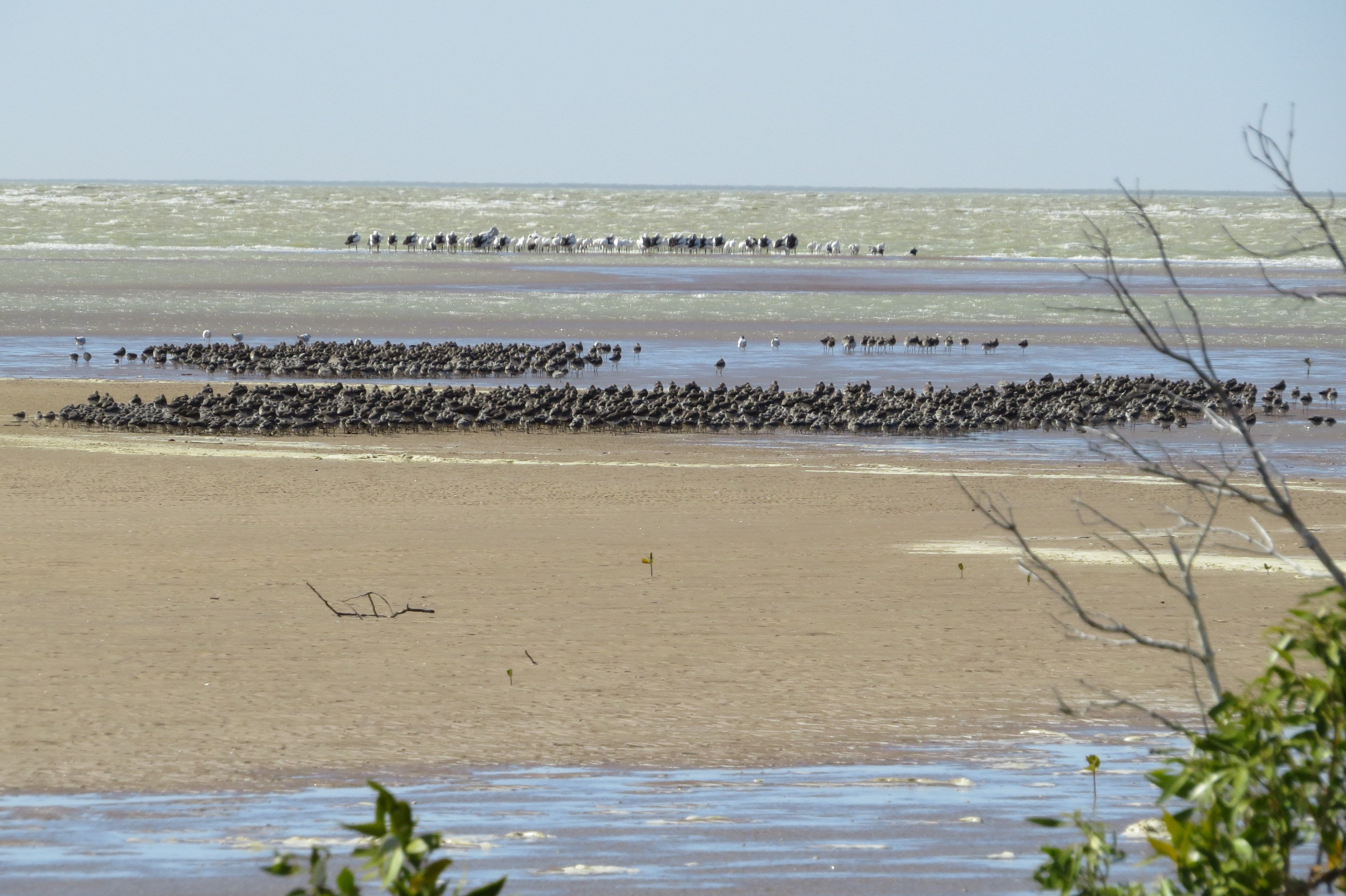|
|
Roosting (Shorebirds)During the period of high tide, when intertidal flats are unavailable for feeding, shorebirds in coastal habitats use this time for preening, digesting, resting and sleeping, which is more generally referred to as roosting. The birds usually gather in groups, or in large flocks, returning to roosting sites they have used previously. Roosting habitat can simply be the upper beach area that is left uncovered by the tide but invariably shorebirds will congregate in the same location(s) along the upper shoreline or somewhere nearby to sit out the high tide. Due to the vulnerability of shorebirds during roosting, special management considerations are required for these areas. Queensland shorebird species - Bird wetland indicator species and profiles Quick facts
Characteristics of good high tide roost sites include the slope of the site and the slope of neighbouring substrate. The latter might determine how useful the adjacent area is for feeding. Other physical characteristics that seem typical of shorebird roost sites and which have been shown to be reproducible in “constructed” or artificial roost sites include: substrate type, extent and depth of tidal inundation, presence of clear ground, absence of hiding places for predators, a good field of view, prevailing winds and wave action, proximity to feeding areas and barriers to predators or disturbances. The control of weed growth including natural successional changes in vegetation, is an important ongoing consideration. CharacteristicsBirds can rest one side of their brains and bodies at a time and it is not unusual to see a shorebird with one eye closed, while standing at rest on a roost site. Tall trees, sand dunes or cliffs nearby can be hideouts for predators, including birds of prey, cats or foxes. On spring tides, whole flocks of birds may fly together onto a site that is well away from where the birds were last feeding. Night time roosts can be much farther from the water’s edge and even on the tops of sand dunes, on saltpans or in open grassy paddocks. Shorebirds can shift to alternative roost sites during the night, especially if predators are better able to conceal themselves at night at some sites rather than others. Appropriate roost sites have characteristics that help to maximise the benefit of safety in numbers. Roost sites are usually in close proximity to the high water mark, at the top of the beach line, on a sandy spit, immediately behind the front line of mangroves on claypan or saltmarsh, or even on rocks near the shoreline. Many species have the need to stand on moist substrate or in shallow water while roosting, especially in hot climates during the day. A suitable roost site is often very close to a gently sloping shoreline where birds can leisurely walk out to feed as the tide recedes or equally, continue feeding as the tide rises and then simply gather together as the tide pushes them into what is left of the upper flat. A good roost site needs to be close to the area used for feeding to limit the time and energy required to commute between the two. Similarly, to minimise unnecessary flying time, a good roost site is one where birds can be undisturbed. Too much interference by people or predators, forcing a flock to take to the air and then resettle, limits the value of the site to shorebirds. The changing high tideIndividual birds are known to regularly return, not only to the same roost site but also to the same favoured feeding area, day and night. A guiding principle is that birds will generally only move far enough away from where they feed as they need to. There can be several neap high tide roost sites in the one area. For intermediate level high tides, a more predictable roosting behaviour occurs, with a regular pattern of a limited number of roost sites used. Flock size can be substantial and birds will fly in from many kilometres away on a rising tide to gather together at a single roost site. On spring high tides, regular roosting sites can be covered with water and unavailable to shorebirds. At these times, shorebirds gather together in even larger numbers at sites that remain available. On unusually high tides, or during severe weather conditions that may further restrict the number of roost sites available, birds may have to fly 20 km or more to find safe, alternative roosting conditions. During these events, roosting behaviour becomes less predictable and roost sites less easily identified because of their infrequent use. Monitoring numbers of shorebirds on very high tides by counting birds at roost is not feasible. Nevertheless, the capacity of an area to provide for shorebirds on very high tides is part of the complexity of feeding and roosting habitat that is required to sustain large numbers of overwintering migratory shorebirds in Queensland. For the bird watcher, roost sites are very useful in allowing detailed observation of individual birds as well as simplifying shorebird counts for population studies. However, the tides chosen for counting are best if they are neither extreme neap tides nor extreme spring tides. Good shorebird observations are made by not disturbing the birds, a benefit to both the observer and the observed. Acknowledgements
Additional informationManagement considerations for shorebird roost sites Disturbance of shorebird roosting and feeding habitat Shorebird locations in Queensland Shorebird high tide roost site mapping layer on WetlandMaps Last updated: 13 October 2023 This page should be cited as: Department of Environment, Science and Innovation, Queensland (2023) Roosting (Shorebirds), WetlandInfo website, accessed 8 May 2025. Available at: https://wetlandinfo.des.qld.gov.au/wetlands/ecology/components/biota/fauna/fauna-taxon/birds/shore-bird/roosting-habitat.html |

 — Department of the Environment, Tourism, Science and Innovation
— Department of the Environment, Tourism, Science and Innovation


